Abstract
OBJECTIVES. A serosurvey of canine exposure to Borrelia burgdorferi, the causative agent of human Lyme disease, was conducted in Westchester County, New York, to determine the distribution of exposure in an area endemic for Lyme disease. METHODS. A total of 1446 blood samples was collected from resident dogs and tested by modified enzyme-linked immunosorbent assay. Equivocal samples were further tested by immunoblot. A mean number of 57.8 samples was collected from each of 25 towns and cities. RESULTS. Seroprevalence rates for municipalities ranged from 6.5% to 85.2%. County seroprevalence was 49.2%. There was a significant difference among the rates for the northern (67.3%), central (45.2%), and southern (17.3%) regions. Multiple range analysis indicated homogeneity between the southern and central regions and the central and northern regions. CONCLUSIONS. Canine exposure to B burgdorferi increases in a south to north gradient within the county. Intensity of exposure, measured by enzyme-linked immunosorbent assay titers, indicates a similar pattern. The close association between dogs and humans suggests that human risk of acquiring Lyme disease within Westchester County is equally disparate and is inversely related to the degree of urbanization.
Full text
PDF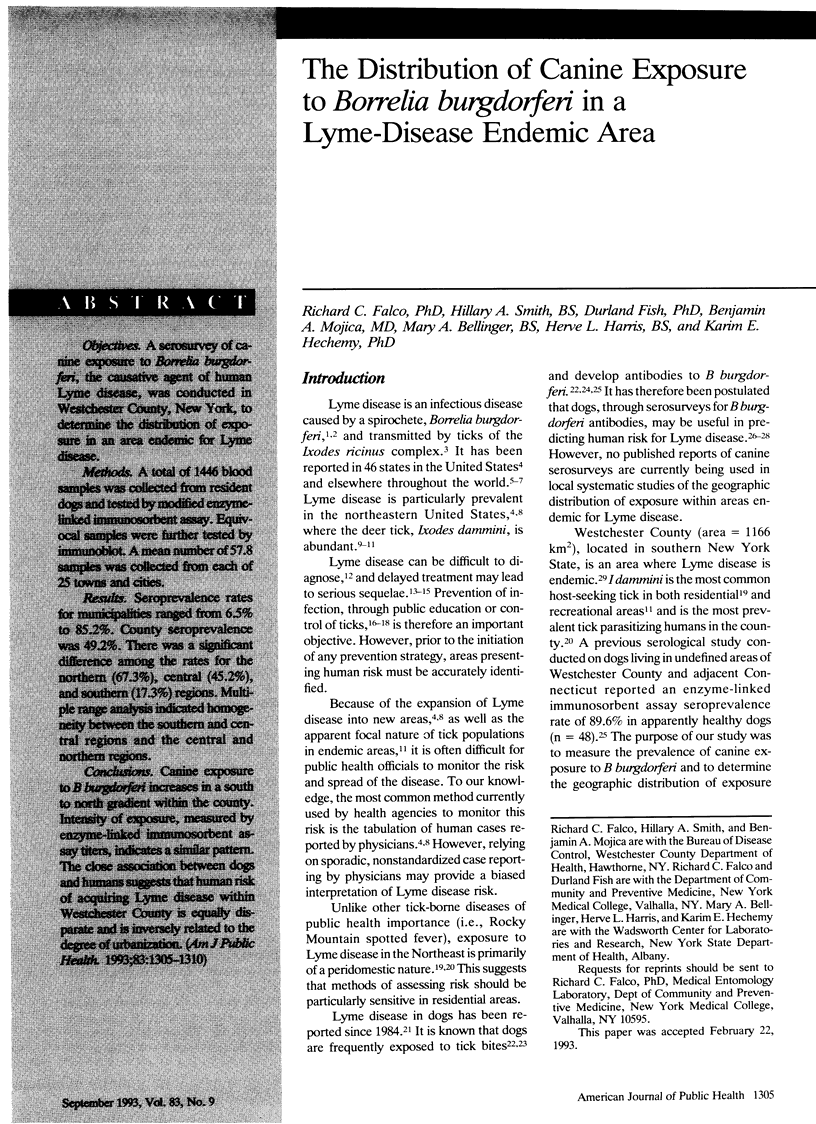
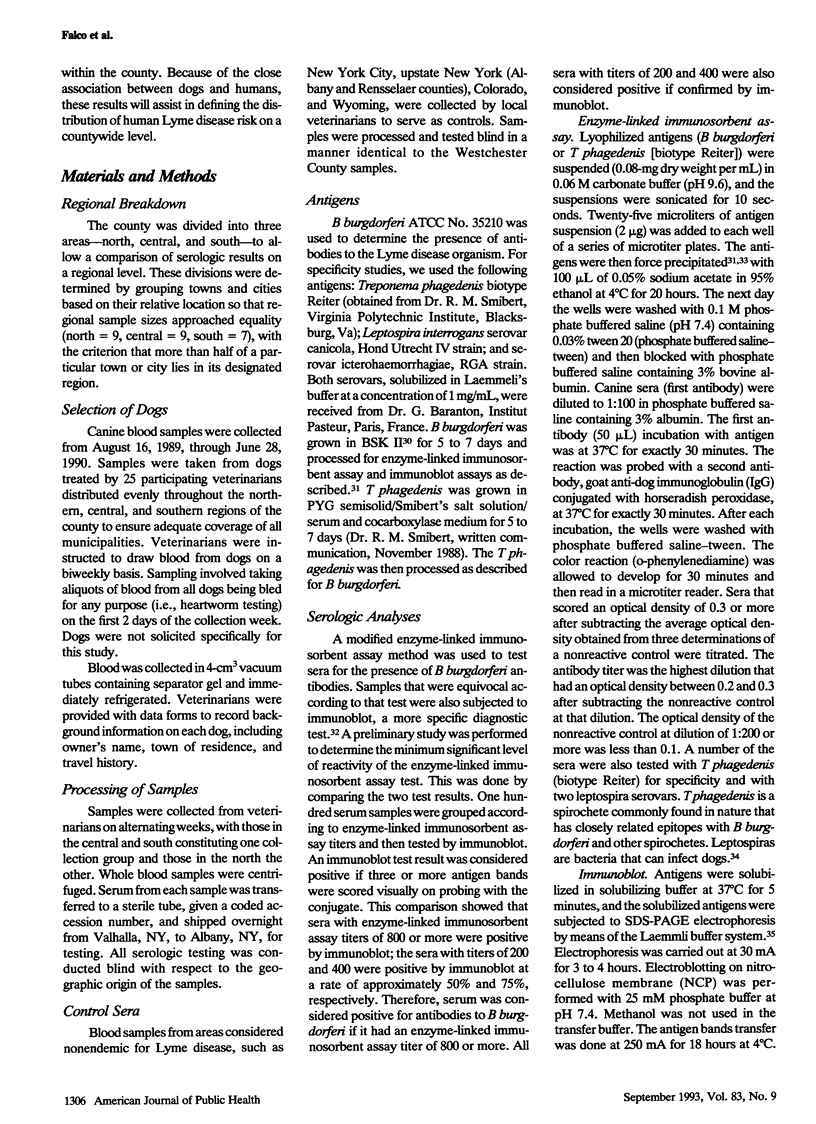
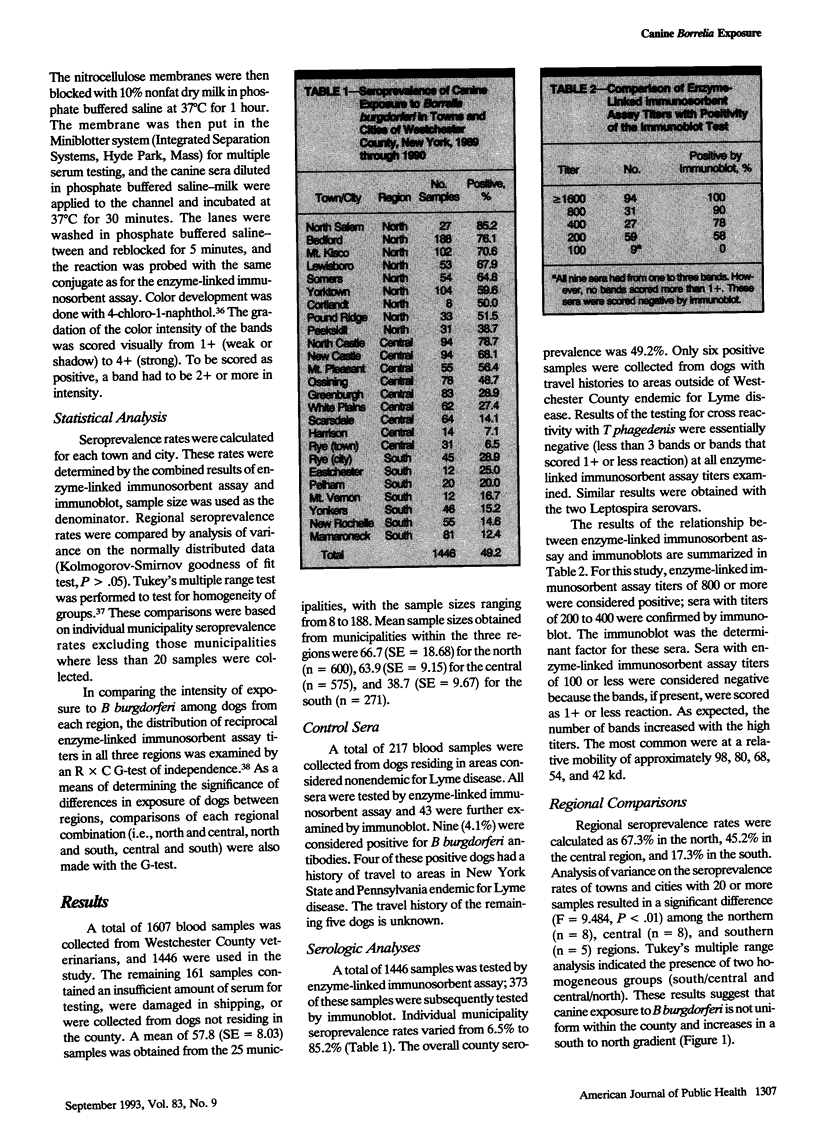
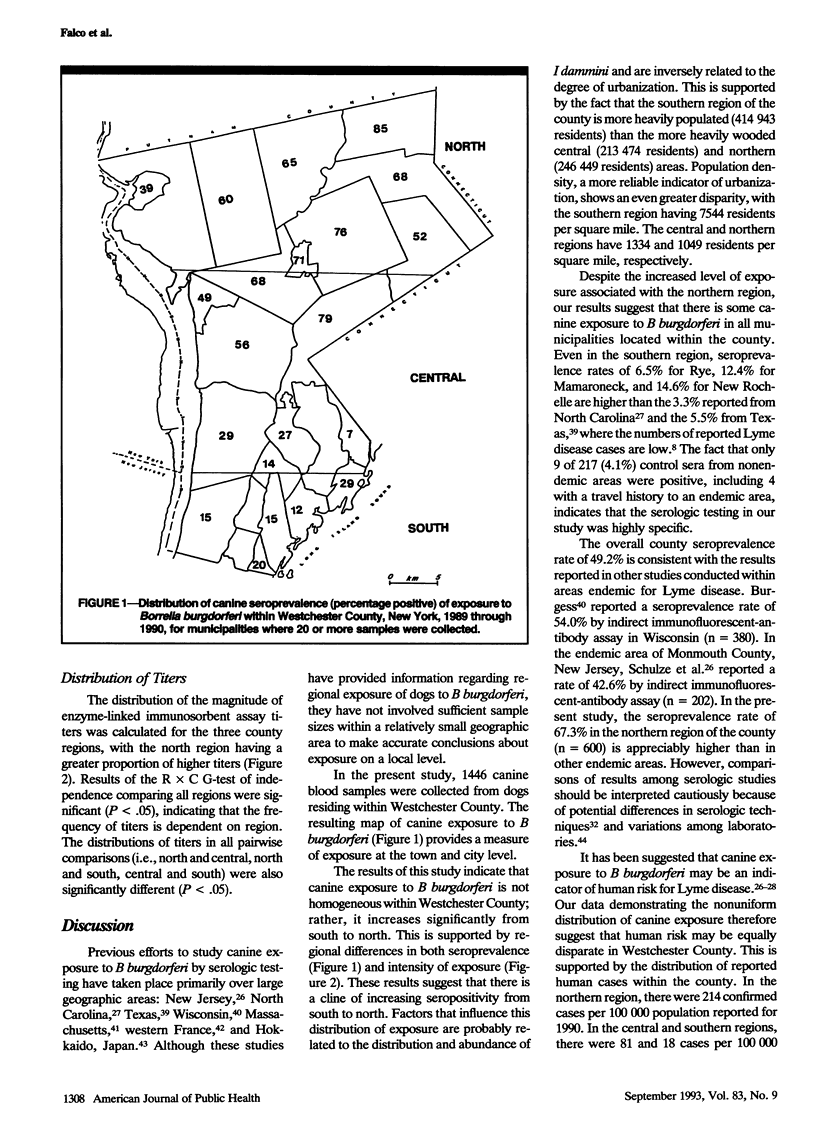
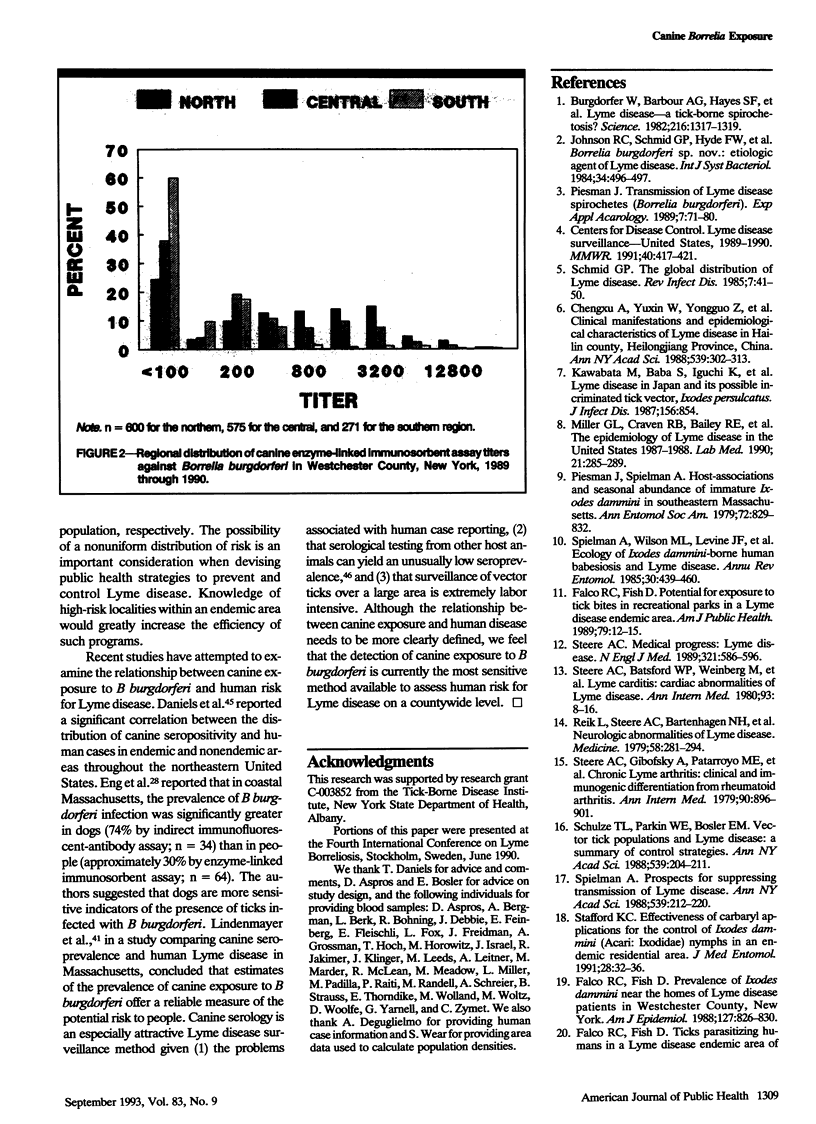
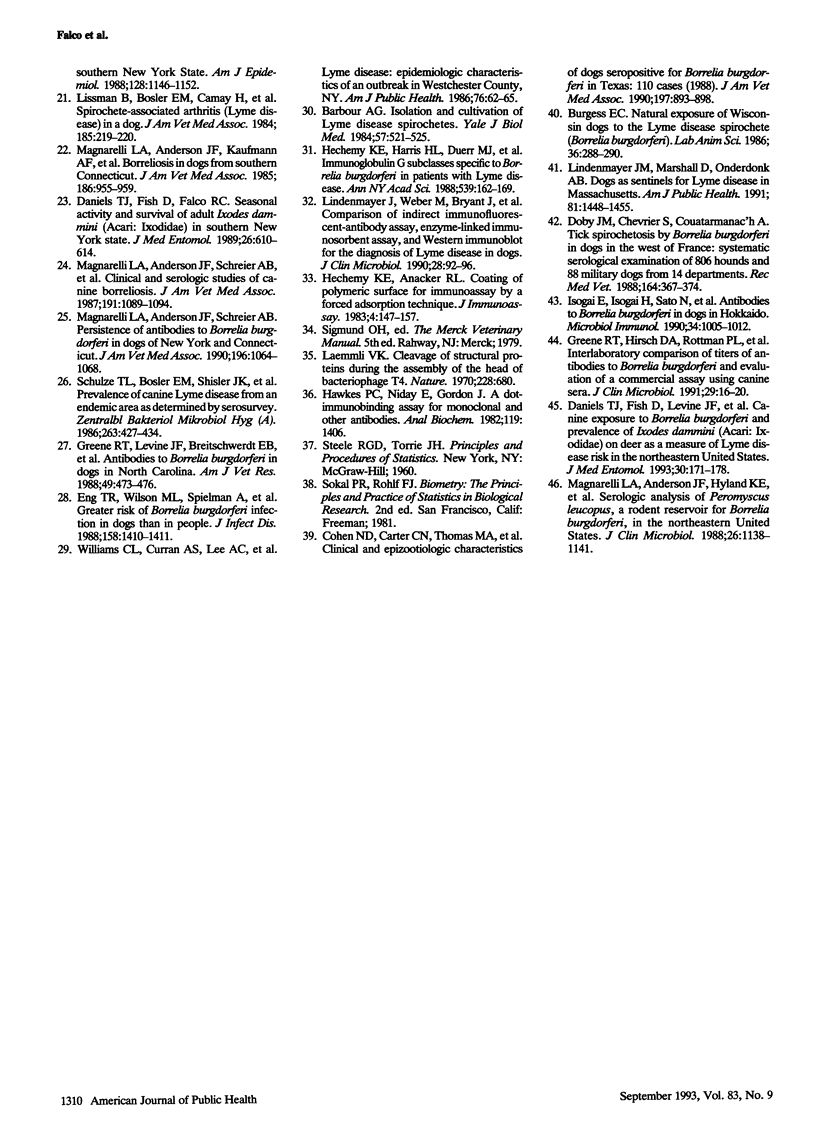
Selected References
These references are in PubMed. This may not be the complete list of references from this article.
- Ai C. X., Wen Y. X., Zhang Y. G., Wang S. S., Qiu Q. C., Shi Z. X., Li D. Y., Chen D. Q., Liu X. D., Zhao J. H. Clinical manifestations and epidemiological characteristics of Lyme disease in Hailin county, Heilongjiang Province, China. Ann N Y Acad Sci. 1988;539:302–313. doi: 10.1111/j.1749-6632.1988.tb31864.x. [DOI] [PubMed] [Google Scholar]
- Barbour A. G. Isolation and cultivation of Lyme disease spirochetes. Yale J Biol Med. 1984 Jul-Aug;57(4):521–525. [PMC free article] [PubMed] [Google Scholar]
- Burgdorfer W., Barbour A. G., Hayes S. F., Benach J. L., Grunwaldt E., Davis J. P. Lyme disease-a tick-borne spirochetosis? Science. 1982 Jun 18;216(4552):1317–1319. doi: 10.1126/science.7043737. [DOI] [PubMed] [Google Scholar]
- Burgess E. C. Natural exposure of Wisconsin dogs to the Lyme disease spirochete (Borrelia burgdorferi). Lab Anim Sci. 1986 Jun;36(3):288–290. [PubMed] [Google Scholar]
- Cohen N. D., Carter C. N., Thomas M. A., Jr, Angulo A. B., Eugster A. K. Clinical and epizootiologic characteristics of dogs seropositive for Borrelia burgdorferi in Texas: 110 cases (1988). J Am Vet Med Assoc. 1990 Oct 1;197(7):893–898. [PubMed] [Google Scholar]
- Daniels T. J., Fish D., Falco R. C. Seasonal activity and survival of adult Ixodes dammini (Acari: Ixodidae) in southern New York State. J Med Entomol. 1989 Nov;26(6):610–614. doi: 10.1093/jmedent/26.6.610. [DOI] [PubMed] [Google Scholar]
- Daniels T. J., Fish D., Levine J. F., Greco M. A., Eaton A. T., Padgett P. J., LaPointe D. A. Canine exposure to Borrelia burgdorferi and prevalence of Ixodes dammini (Acari: Ixodidae) on deer as a measure of Lyme disease risk in the northeastern United States. J Med Entomol. 1993 Jan;30(1):171–178. doi: 10.1093/jmedent/30.1.171. [DOI] [PubMed] [Google Scholar]
- Eng T. R., Wilson M. L., Spielman A., Lastavica C. C. Greater risk of Borrelia burgdorferi infection in dogs than in people. J Infect Dis. 1988 Dec;158(6):1410–1411. doi: 10.1093/infdis/158.6.1410. [DOI] [PubMed] [Google Scholar]
- Falco R. C., Fish D. Potential for exposure to tick bites in recreational parks in a Lyme disease endemic area. Am J Public Health. 1989 Jan;79(1):12–15. doi: 10.2105/ajph.79.1.12. [DOI] [PMC free article] [PubMed] [Google Scholar]
- Falco R. C., Fish D. Prevalence of Ixodes dammini near the homes of Lyme disease patients in Westchester County, New York. Am J Epidemiol. 1988 Apr;127(4):826–830. doi: 10.1093/oxfordjournals.aje.a114865. [DOI] [PubMed] [Google Scholar]
- Greene R. T., Hirsch D. A., Rottman P. L., Gerig T. M. Interlaboratory comparison of titers of antibody to Borrelia burgdorferi and evaluation of a commercial assay using canine sera. J Clin Microbiol. 1991 Jan;29(1):16–20. doi: 10.1128/jcm.29.1.16-20.1991. [DOI] [PMC free article] [PubMed] [Google Scholar]
- Greene R. T., Levine J. F., Breitschwerdt E. B., Berkhoff H. A. Antibodies to Borrelia burgdorferi in dogs in North Carolina. Am J Vet Res. 1988 Apr;49(4):473–476. [PubMed] [Google Scholar]
- Hechemy K. E., Anacker R. L. Coating of polymeric surfaces for immunoassay by a forced adsorption technique. J Immunoassay. 1983;4(2):147–157. doi: 10.1080/15321818308057007. [DOI] [PubMed] [Google Scholar]
- Hechemy K. E., Harris H. L., Duerr M. J., Benach J. L., Reimer C. B. Immunoglobulin G subclasses specific to Borrelia burgdorferi in patients with Lyme disease. Ann N Y Acad Sci. 1988;539:162–169. doi: 10.1111/j.1749-6632.1988.tb31849.x. [DOI] [PubMed] [Google Scholar]
- Isogai E., Isogai H., Sato N., Yuzawa M., Kawakami M. Antibodies to Borrelia burgdorferi in dogs in Hokkaido. Microbiol Immunol. 1990;34(12):1005–1012. doi: 10.1111/j.1348-0421.1990.tb01522.x. [DOI] [PubMed] [Google Scholar]
- Kawabata M., Baba S., Iguchi K., Yamaguti N., Russell H. Lyme disease in Japan and its possible incriminated tick vector, Ixodes persulcatus. J Infect Dis. 1987 Nov;156(5):854–854. doi: 10.1093/infdis/156.5.854. [DOI] [PubMed] [Google Scholar]
- Laemmli U. K. Cleavage of structural proteins during the assembly of the head of bacteriophage T4. Nature. 1970 Aug 15;227(5259):680–685. doi: 10.1038/227680a0. [DOI] [PubMed] [Google Scholar]
- Lindenmayer J. M., Marshall D., Onderdonk A. B. Dogs as sentinels for Lyme disease in Massachusetts. Am J Public Health. 1991 Nov;81(11):1448–1455. doi: 10.2105/ajph.81.11.1448. [DOI] [PMC free article] [PubMed] [Google Scholar]
- Lindenmayer J., Weber M., Bryant J., Marquez E., Onderdonk A. Comparison of indirect immunofluorescent-antibody assay, enzyme-linked immunosorbent assay, and Western immunoblot for the diagnosis of Lyme disease in dogs. J Clin Microbiol. 1990 Jan;28(1):92–96. doi: 10.1128/jcm.28.1.92-96.1990. [DOI] [PMC free article] [PubMed] [Google Scholar]
- Lissman B. A., Bosler E. M., Camay H., Ormiston B. G., Benach J. L. Spirochete-associated arthritis (Lyme disease) in a dog. J Am Vet Med Assoc. 1984 Jul 15;185(2):219–220. [PubMed] [Google Scholar]
- Magnarelli L. A., Anderson J. F., Hyland K. E., Fish D., Mcaninch J. B. Serologic analyses of Peromyscus leucopus, a rodent reservoir for Borrelia burgdorferi, in northeastern United States. J Clin Microbiol. 1988 Jun;26(6):1138–1141. doi: 10.1128/jcm.26.6.1138-1141.1988. [DOI] [PMC free article] [PubMed] [Google Scholar]
- Magnarelli L. A., Anderson J. F., Kaufmann A. F., Lieberman L. L., Whitney G. D. Borreliosis in dogs from southern Connecticut. J Am Vet Med Assoc. 1985 May 1;186(9):955–959. [PubMed] [Google Scholar]
- Magnarelli L. A., Anderson J. F., Schreier A. B., Ficke C. M. Clinical and serologic studies of canine borreliosis. J Am Vet Med Assoc. 1987 Nov 1;191(9):1089–1094. [PubMed] [Google Scholar]
- Magnarelli L. A., Anderson J. F., Schreier A. B. Persistence of antibodies to Borrelia burgdorferi in dogs of New York and Connecticut. J Am Vet Med Assoc. 1990 Apr 1;196(7):1064–1068. [PubMed] [Google Scholar]
- Piesman J. Transmission of Lyme disease spirochetes (Borrelia burgdorferi). Exp Appl Acarol. 1989 Jun;7(1):71–80. doi: 10.1007/BF01200454. [DOI] [PubMed] [Google Scholar]
- Reik L., Steere A. C., Bartenhagen N. H., Shope R. E., Malawista S. E. Neurologic abnormalities of Lyme disease. Medicine (Baltimore) 1979 Jul;58(4):281–294. doi: 10.1097/00005792-197907000-00001. [DOI] [PubMed] [Google Scholar]
- Schmid G. P. The global distribution of Lyme disease. Rev Infect Dis. 1985 Jan-Feb;7(1):41–50. doi: 10.1093/clinids/7.1.41. [DOI] [PubMed] [Google Scholar]
- Schulze T. L., Bosler E. M., Shisler J. K., Ware I. C., Lakat M. F., Parkin W. E. Prevalence of canine Lyme disease from an endemic area as determined by serosurvey. Zentralbl Bakteriol Mikrobiol Hyg A. 1987 Feb;263(3):427–434. doi: 10.1016/s0176-6724(87)80104-9. [DOI] [PubMed] [Google Scholar]
- Schulze T. L., Parkin W. E., Bosler E. M. Vector tick populations and Lyme disease. A summary of control strategies. Ann N Y Acad Sci. 1988;539:204–211. doi: 10.1111/j.1749-6632.1988.tb31854.x. [DOI] [PubMed] [Google Scholar]
- Spielman A. Prospects for suppressing transmission of Lyme disease. Ann N Y Acad Sci. 1988;539:212–220. doi: 10.1111/j.1749-6632.1988.tb31855.x. [DOI] [PubMed] [Google Scholar]
- Spielman A., Wilson M. L., Levine J. F., Piesman J. Ecology of Ixodes dammini-borne human babesiosis and Lyme disease. Annu Rev Entomol. 1985;30:439–460. doi: 10.1146/annurev.en.30.010185.002255. [DOI] [PubMed] [Google Scholar]
- Stafford K. C., 3rd Effectiveness of carbaryl applications for the control of Ixodes dammini (Acari: Ixodidae) nymphs in an endemic residential area. J Med Entomol. 1991 Jan;28(1):32–36. doi: 10.1093/jmedent/28.1.32. [DOI] [PubMed] [Google Scholar]
- Steere A. C., Batsford W. P., Weinberg M., Alexander J., Berger H. J., Wolfson S., Malawista S. E. Lyme carditis: cardiac abnormalities of Lyme disease. Ann Intern Med. 1980 Jul;93(1):8–16. doi: 10.7326/0003-4819-93-1-8. [DOI] [PubMed] [Google Scholar]
- Steere A. C., Gibofsky A., Patarroyo M. E., Winchester R. J., Hardin J. A., Malawista S. E. Chronic Lyme arthritis. Clinical and immunogenetic differentiation from rheumatoid arthritis. Ann Intern Med. 1979 Jun;90(6):896–901. doi: 10.7326/0003-4819-90-6-896. [DOI] [PubMed] [Google Scholar]
- Steere A. C. Lyme disease. N Engl J Med. 1989 Aug 31;321(9):586–596. doi: 10.1056/NEJM198908313210906. [DOI] [PubMed] [Google Scholar]
- Williams C. L., Curran A. S., Lee A. C., Sousa V. O. Lyme disease: epidemiologic characteristics of an outbreak in Westchester County, NY. Am J Public Health. 1986 Jan;76(1):62–65. doi: 10.2105/ajph.76.1.62. [DOI] [PMC free article] [PubMed] [Google Scholar]


